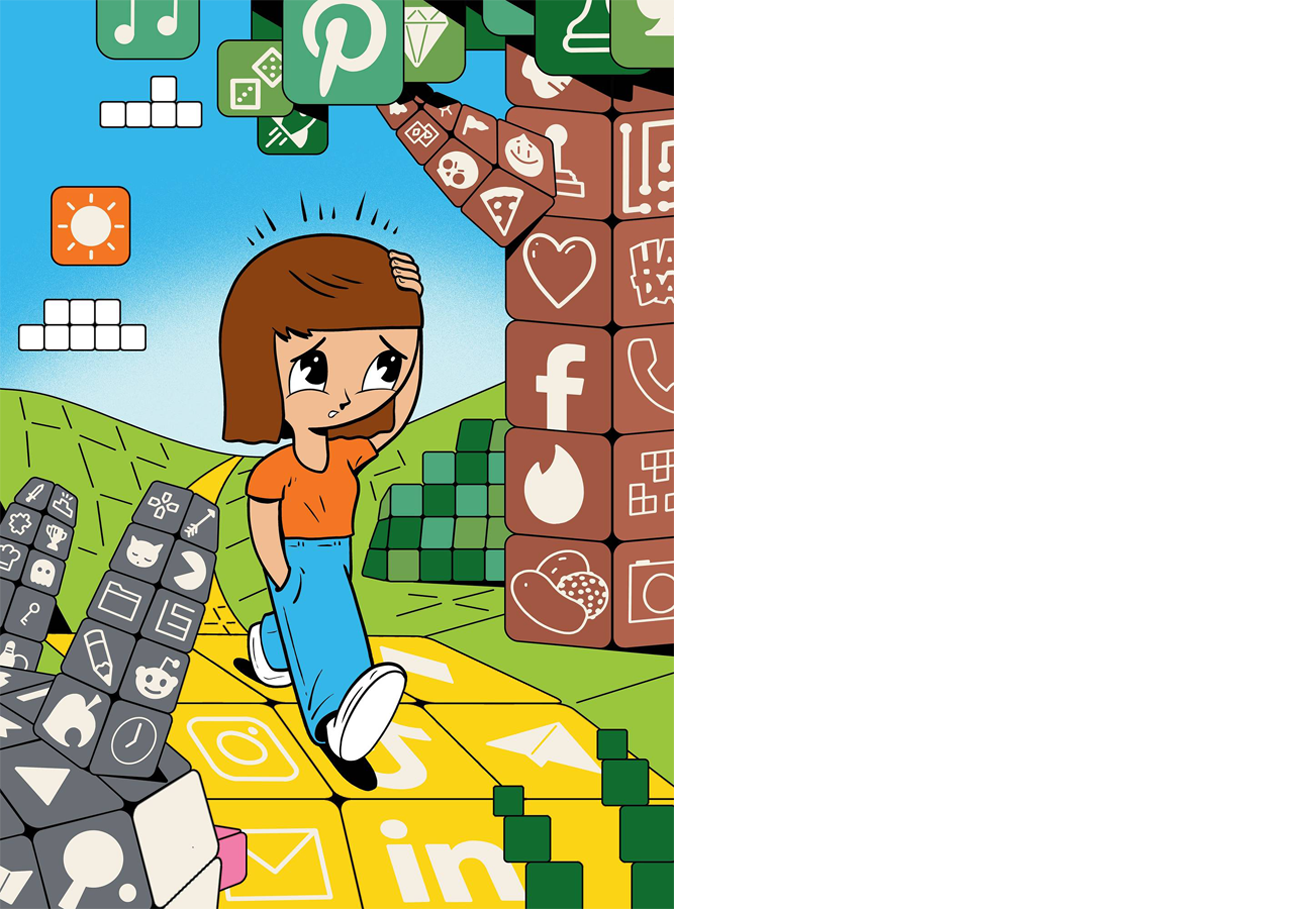Helyn Trickey Bradley, MFA, is a journalist based in Portland, Oregon. She writes essays and articles for national publications including O, The Oprah Magazine, CNN, PBS and The Oregonian.
Author Page
Breaking Up With App Addiction
Management and moderation — from dating to dopamine — help keep brains in balance
ILLUSTRATIONS BY RYAN SNOOK
Health & Well-Being
Kristen (name changed) first suspected she might have a problem when she found herself checking her Facebook app every morning before getting out of bed.
“I felt like I was giving social media the first and best part of my day,” she said. It wasn’t just her mornings that were given over to screen-scrolling through apps. Kristen’s husband had mentioned more than once that she seemed “checked out,” and her children often repeated themselves because Kristen was riveted to her Facebook feed instead of listening. She found herself unlocking her phone to access Facebook and other apps hundreds of times per day.
Because Kristin’s profession includes digital creation for her business, disconnecting from an app that kept her engaged with her clients was impossible. But controlling her time on Facebook proved challenging, too.
“The algorithm is designed to keep you scrolling, feeding you content that tugs at you,” she said. “What started as a five-minute check-in would turn into 30 minutes, and I found myself mindlessly scrolling for hours every day.”
Kristen’s preoccupation with her phone apps was taking a physical toll, too: “Physically, I was dealing with headaches and eye strain. Mentally, I felt foggy, easily distracted, stressed and often overwhelmed.”
Kristen’s physical and mental responses to her excessive use mirror classic signs of addiction, said Heinz Steiner, PhD, professor emeritus at Chicago Medical School. “The brain functions best in a stable state, and it doesn’t like to be stimulated too much. With too much activation, the brain will slam on the brakes, and cells will become more resistant to ‘feel-good’ neurotransmitters like dopamine.”
In her book, “Dopamine Nation: Finding Balance in the Age of Indulgence,” Anna Lembke, MD, argues that we are all addicts to a degree, given the ubiquitous nature of smartphones and apps and our natural propensity to continually seek quick hits of dopamine. “We’re seeing a huge explosion in the numbers of people struggling with minor addictions,” she writes.
Battle Lines: Attacking App Addiction
Anna Lembke, MD, author of the book “Dopamine Nation: Finding Balance in the Age of Indulgence,” suggests steps people can take to break the bond of app/social media addiction:
Abstinence: Give yourself at least four weeks of abstinence from apps and social media. This break allows your brain’s reward pathway to reset from dopamine overload and think more clearly.
Distance: Create physical distance between you and your addiction. Maybe you have one device you use only for work and another for the apps you enjoy. Perhaps you access your apps only during certain hours.
Honesty: Practice radical honesty with yourself and others. Honesty begets intimacy, and authentic connection is a source of healthy dopamine levels.
Alternatives: Strive for a pleasure/pain equilibrium in your brain by seeking out alternative healthy activities that have small pain points along the way, such as moderate exercise, meditation or learning a new skill.
From habit to compulsion
At a basic level, addiction begins when we do something that feels good: We gamble on a sporting event, binge-watch a show on Netflix, fill our online shopping carts, smoke a cigarette or surf on a dating app. The action feels good because the brain’s reward pathway — a circuit linking the ventral tegmental area, the nucleus accumbens and the prefrontal cortex — is flooded with a number of neurotransmitters, the most important being dopamine, a chemical associated with feelings of pleasure and well-being.
When Ellen (name changed) first logged in to a dating app after a bruising divorce, she was thrilled to find a vibrant community of like-minded adults. Soon, she found herself using the apps more and more, thrilled when a sound notification indicated another user had sent her a message. Before long, she’d downloaded a host of other dating apps, spending as much as eight hours a day scrolling through dating profiles and avoiding work to spend more time online. Through one of her dating apps alone, Ellen could get as many as 50 notifications per day.
“I felt like a Pavlovian doggie every time it dinged — I’d get a little shot of happy through my body,” she said.
“Our brain’s reward center makes you repeat the action, and over time, this will shift the involved neural pathways in our brains, so the behavior can become a habit and, in extreme cases, a compulsion,” Dr. Steiner said. The more dopamine, and the faster it’s released into our brain’s reward center, the more addictive a substance or behavior is deemed.
“An addiction disorder is a compulsion disorder — you have to do the drug or behavior, or you feel bad,” Dr. Steiner said. “And this shift is important. You begin to feel sick, and instead of being pleasure-seeking, the compulsion becomes about avoiding feeling bad. Your life suffers.”
Designed to addict
Apps are cleverly designed to capture our attention and to keep us scrolling longer, mostly in an attempt to scrape more and more user data, according to a 2019 article in the International Journal of Environmental Research and Public Health titled “Addictive Features of Social Media/Messenger Platforms and Freemium Games Against the Background of Psychological and Economic Theories.”
According to the study’s lead researcher, Professor Dr. Christian Montag, tactics app developers employ to snag and keep users include inducing a state of user flow, the endowment/mere exposure effect and the Zeĭgarnik/Ovsiankina effects.
“Flow” refers to a state of deep absorption in a task, especially one that requires us to push past something difficult to achieve results. We often lose track of time in this valuable state, but the payoff in our brain chemistry is a steady drip of dopamine that doesn’t overwhelm our reward pathway. Flow is the brain state many of us naturally attain when we begin to master a new skill.
Smartphone apps can drop us too quickly into a state of flow without us having to overcome any difficulty to get there. The result is a large wash of dopamine and other neurotransmitters that flood our reward pathways and don’t let up.
“It is well known that flow goes along with a feeling of time distortion, and this is exactly what many developers of social media apps and freemium games aim to achieve — a person being so immersed that he or she is forgetting about time and space,” Dr. Montag reports.
Those who spend time on world-building games such as Minecraft will recognize the pull of the endowment/mere exposure effect. During early use, players can build an island, farm or personalized platform, adding free amenities that encourage engagement. Research shows the more time users invest in constructing a familiar world, the more difficult it is for them to abandon the app. Even dating apps that require users to spend time building elaborate profiles complete with pictures and videos benefit from the endowment/mere exposure effect. The more time people spend answering personal questions and building up content, the more loath they are to abandon the platform.
Another way app developers keep users hooked is by purposefully interrupting them when they are engaged in rigorous, high-investment tasks. Most users feel emotionally strained, getting relief only by returning to the task later to complete it. This is called the Zeĭgarnik/Ovsiankina effects, named after the social scientists who first observed and reported the behavior. Games such as Candy Crush Saga offer free “lives” to players who’ve abandoned the game. When players reengage, they are challenged to “super hard levels” and lose several of those free lives. By losing, users experience an interruption and are more attracted to the game than ever before, seeking to finish the task and finding redemption in the next game level.
According to the Pew Research Institute, 85% of Americans self-report they go online daily, and 31% say they are online “almost constantly.” While the lion’s share of constantly connected adults are, unsurprisingly, digital natives (18- to 29-year-olds), adults ages 30–64 are joining their ranks quickly. The number of constantly online Americans ages 30–49 ticked up 14 points since 2015, and the share of 50- to 64-year-olds ballooned from 12% in 2015 to 22% in 2021.

Kicking the dopamine monster
The human brain reflexively seeks out pleasure and avoids pain at all costs. This evolutionary advantage can also hobble us, especially with so many quick dopamine delivery systems now at our fingertips.
Experts advise being more judicious about how we get our dopamine, avoiding “feel-good” neurotransmitter super-soaker activities — such as unchecked app usage — in favor of harder-won dopamine-delivery activities, such as learning how to play a new musical instrument or trying a new sport. By purposefully getting our dopamine dosage in smaller, more manageable bits, we can better keep our brain chemistry in balance.
Ellen, the woman who struggled with a dating-app addiction, brought her troubling behavior to the attention of her therapist, who advised her to abstain for a month. Ellen also changed her behavior, meeting with friends face-to-face instead of online, taking a sculpture class and going to the theater more often.
In the end, Ellen returned to dating apps but with a number of self-imposed restrictions. “I don’t allow any notifications on my dating apps — no sounds, no alerts of any kind,” she said. “And I can’t look at the apps while I’m working at my desk.”
The gold standard for treating app/social media addiction is Cognitive Behavioral Therapy (CBT), and antidepressants can sometimes aid in dulling a patient’s brain’s pleasure center. But for most people trying to kick a habit, the psychology of behavior matters.
“It’s usually not the thing itself; it’s how the addictive behavior or substance is used,” said Nancy Jao, PhD, assistant professor and director of The Health, Behaviors and Tobacco Use (HaBiT) Research Lab at RFU. “It’s the meaning the person struggling with addiction is taking from whatever they’re using.”
Research conducted by Dr. Jao primarily focuses on understanding the impact of tobacco product use on health outcomes. Still, she sees common connections between someone trying to quit smoking and someone struggling to manage their TikTok use.
“Addictive behaviors often serve a purpose for the individual, even if unconsciously. Otherwise, it would be much easier to stop,” Dr. Jao said. “Are they smoking to feel better? Because they’re hungry? Because their family or friends smoke? Even boredom can be a reason. The most effective way to address the behavior often depends on the underlying reasons for use.”
Kristen, the woman who couldn’t stop scrolling through Facebook, also took steps to end her dependence. She removed the apps from her phone, and she only accesses them on her desktop computer during specific times of the day.
Both women reported feelings of withdrawal.
Ellen said she felt a physical sensation, a craving for attention she’s had to manage as she settles back into her moderate dating-app usage.
And Kristen admitted the first few days without her phone apps were rough: “I was constantly reaching for my phone out of habit. There was a strange emptiness that made me realize how much social media had been filling space in my mind and soul.
“You only get one life — don’t scroll it away.”
For her, this newfound control over her addiction isn’t only about getting more time back in her day. “It was about reclaiming my attention, my peace and my purpose.”
Kids, Too
Most existing research on mental health and screen-based activities for U.S. youth focuses on the amount of total screen time — the time spent engaging with mobile phones and tablets. But a study published in June 2025 in the medical journal JAMA found that it’s screen addiction that may be the bigger risk factor for suicidality and mental health in youth.
According to the study “Addictive Screen Use Trajectories and Suicidal Behaviors, Suicidal Ideation, and Mental Health in US Youths”:
- 48% of young adolescents report losing track of how much they are using their phone.
- 25% use social media to forget about their problems.
- 25% admit to spending a considerable amount of time thinking about social media apps.
- 17% have tried to reduce their social media use but cannot.
- 11% acknowledge that their screen use has negatively affected their schoolwork.
“The researchers found addictive behavior to be very common among children — especially in their use of mobile phones, where nearly half had high addictive use,” Ellen Barry wrote in The New York Times. “By age 14, children with high or increasing addictive behavior were two to three times as likely as other children to have thoughts of suicide or to harm themselves, the study found.”
Published November 21, 2025

